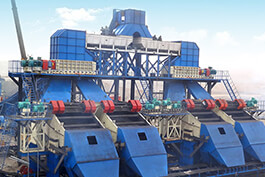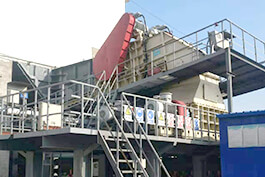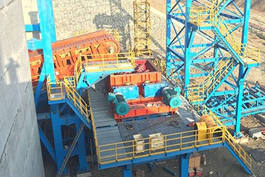In order to meet the production and development requirements of the coal preparation plant and solve problems such as screening efficiency and controlling the upper limit of particle size, our Malaysian customer cooperated with our company in January 2025. According to the special requirements of the production process, a pre-screening device - heavy-duty roller screen - was added to the raw coal crushing line before crushing.
After thorough design and repeated revisions, the preliminary design scheme of the new roller coal screening machine was completed in April 2025. After the argumentation, the design will be completed and the materials will be cut for production in July 2025. The equipment processing and assembly will be completed in September 2025. After passing the test, it will be allowed to leave the factory. The packaging has been completed and the goods have been smoothly loaded and dispatched.
The working principle of roller screens
After the coal enters the screen box through the coal inlet, the flow direction of the coal inlet is controlled by the baffle driven by the electric push rod. The rollers are arranged in a stepwise inclined manner in sequence to form a screen surface, and each roller is driven independently by a separate motor. When the baffle position is on the screening surface, the roller screen starts to operate. Under the dual action of its own weight and the rotation of the screen plates, the coal moves down at a relatively fast speed and is screened simultaneously. Small-sized raw coal falls from the coal outlet on the screening surface and enters the next transfer station. Large pieces of raw coal fall from the large coal outlet and are sent to the crusher for crushing. When the baffle is in the bypass position, all the coal falls from the bypass coal outlet.
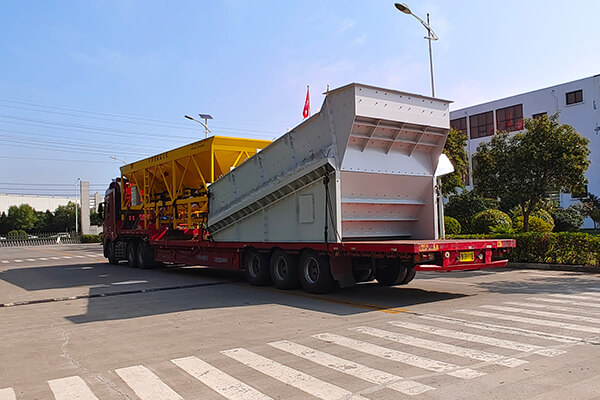
The structural design of roller screens
Each screen shaft of the roller screen is equipped with a set of drive devices to drive the screen shafts. A screen plate cleaner is installed at the lower part of the screen shaft to keep the screen plates clean. The screen plates of the roller screen are all cast from manganese steel. The control circuit of the roller motor is equipped with an air switch overload protection device. When the screen shaft is blocked, it can automatically alarm and cut off the motor. The screen shaft and the reducer are equipped with nylon shearing pins. When there is a sudden large torque, the shearing pins can be used to cut off, protecting the motor.
The roller screen has a total of 10 shafts, and each shaft is equipped with a reduction motor. Such a design and installation not only enable the 10 shafts to work independently without interfering with each other, enhancing the safety working factor of the roller screen, but also reduce the cost of the equipment and facilitate installation.
An overload protection device is installed on the screen shaft. In the middle of the coupling, nylon sleeve pins are used. When the screen shaft gets stuck, the nylon sleeve pins will break due to excessive shear force, achieving overload protection.
The roller screen is equipped with a bypass system, which enables automatic control. When the current coal volume is large and far exceeds the working capacity of the roller screen, coal will clog the interior of the machine box. When the pressure exerted by the coal on the box reaches a certain time and pressure, the pressure sensor will respond, and the electric push rod will act, keeping the baffle in a vertical position, allowing the screened coal to fall directly to protect the equipment and facilitate maintenance.
Roller screens have high screening efficiency, large production capacity, good sealing performance, low noise, small vibration, and can automatically clean the screen surface without clogging. They are easy to install and maintain, and are safe and reliable to use. The roller screen is a rolling screen surface composed of multiple rollers driven independently by a reduction motor. Each screen shaft is equipped with a gradually opening toothed screen plate. The screen shaft is connected to the reduction motor by an elastic pin, which not only provides overload protection but also facilitates maintenance. The materials can be sieved through the screen surface or pass through the bypass.
Existing problems
One end of the roller is supported by a bearing, and the other end is directly connected to the output shaft of the transmission mechanism through a rigid coupling, with the bearing of the output shaft of the transmission mechanism as the support. Due to the long length of the rollers, during operation, they are subjected to the impact force of falling coal blocks and the force generated by the mutual squeezing of coal blocks between each screen shaft. The combined force is relatively large, and the force application is rather complex. Therefore, the deformation of the roller screen during operation is relatively large.
Some roller screens will connect the centers of the cross-sections of each roller to form a banana shape. Although this arrangement has the feature of high screening rate, this type of roller screen is prone to problems such as coal material blockage, insufficient working capacity and motor burnout.
The material of the screen plates is ductile iron, which has poor wear resistance. Once the screen plates are worn, the particle size of the coal screening will not meet the requirements, affecting thermal power generation and thus the economic benefits of the power plant.
Conclusion
In terms of the overall structure, the traditional coal screening machine has been improved by adopting an inclined linear layout, which ensures that there will be no coal material blockage or motor burnout and other phenomena that affect coal screening under overload and continuous operation, greatly enhancing the screening capacity of the roller screen.
In the design of the roller screen, two bearings are adopted, and the rollers and the reduction motor are connected by elastic pin couplings. This not only makes the position of the rollers more fixed but also reduces the impact of roller deformation on the drive device.



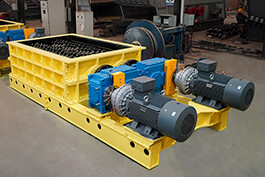
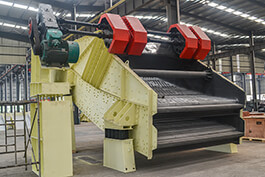
.jpg)

